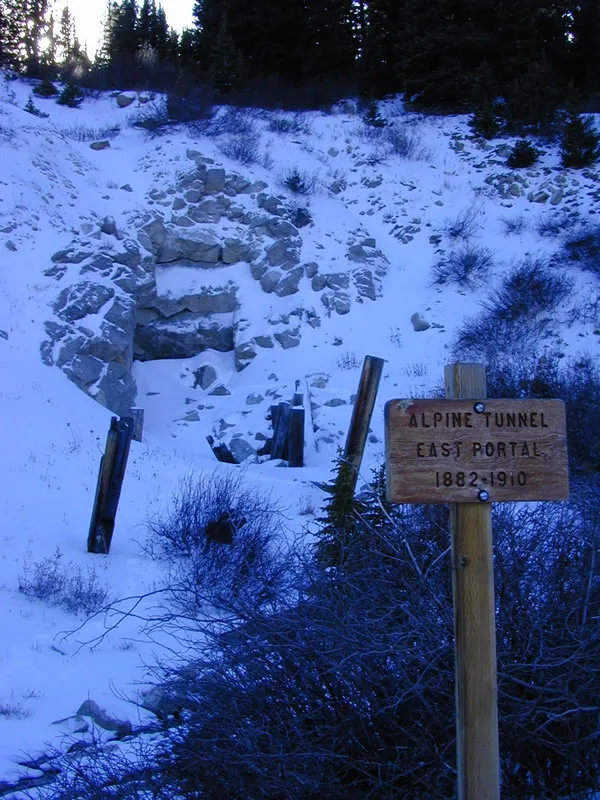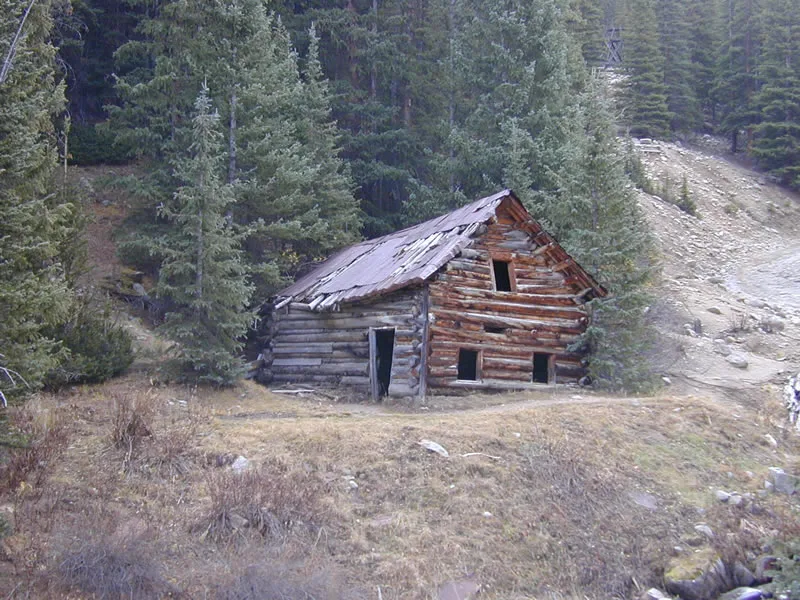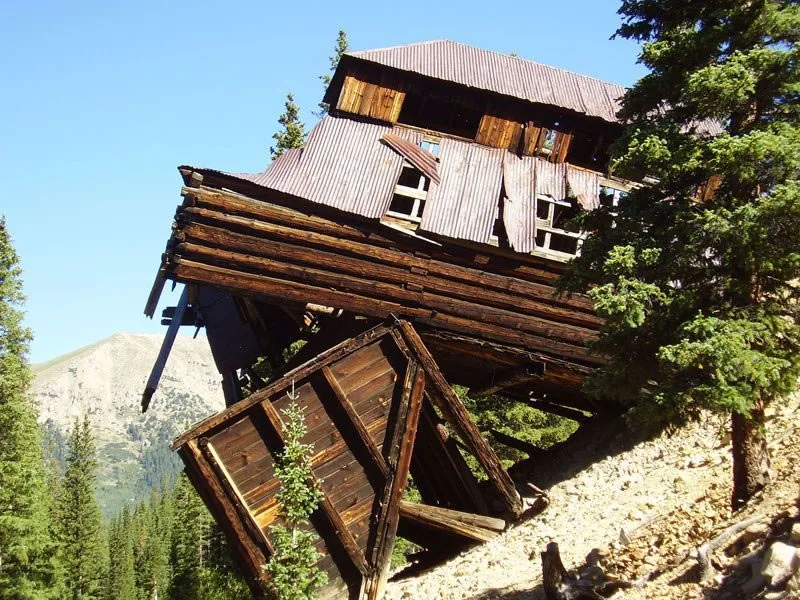A major tourist attraction in the Salida region is that of the ghost towns. These remnants of a colorful past are scattered throughout the upper Arkansas Valley. Most are haunting reminders of economic collapse and other disasters that led to the abandonment of the town. What remains in place of the bygone days of prosperity continues to fascinate and draw droves of tourists. While furious gold mining, boisterous saloons, and vigilante justice once reigned supreme, today these regions are noted for their lethargic serenity.
Read more about the history of Salida and Buena Vista, Colorado.
This is perhaps the most well-preserved of Colorado’s ghost towns. To get here, take CR 162 past Chalk Creek and drive for about 19 miles to the town of St. Elmo. The drive itself is well worthwhile as there are spectacular views along the way, including possible sightings of the area’s year-round native inhabitants—Rocky Mountain bighorn sheep, antelope, and mule deer.

Gold was discovered in 1875 just west of St. Elmo and it wasn’t long after this discovery that the local Mary Murphy Mine became the biggest gold producer in the area. By 1881, the town and the gold had attracted 2000 residents. As more miners discovered gold, the town population continued to grow.
In December of 1880, the Denver, South Park and Pacific Railroad finally reached St. Elmo from Buena Vista. Within three years, there were approximately 50 producing mines in the area.
In the early 1880s, St. Elmo’s community of 2000 residents had three hotels, five restaurants, a drugstore, and a schoolhouse. Rich with ore, the town was a base for the workers at the Mary Murphy Mine, an operation that produced more than $60 million in gold and employed hundreds of workers.
By the 1930s, only about 300 residents remained. A fire in the summer of 2002 destroyed four historical buildings. Today, St. Elmo offers tours throughout the town, which is presently under historical restoration. Twenty-four original buildings remain and there are a total of 8—yes, eight—year-round residents in St. Elmo.
This once-it-was-a-town is located approximately 4 miles past St. Elmo. Initially the town was known as “red town,” a label referring to its buildings which were painted red with white trim. The decaying remains of the town of Romley, however, were leveled several years ago. The town once had a few hundred residents and was a key hub in the Mary Murphy Mine operation. It quickly died and its residents moved out in 1926 when the railroad closed down and the rails were removed. Today, much of this area is on private property and is riddled with underground tunnels and shafts. It is wise to travel this region responsibly and to obey posted signs.
The Mary Murphy Mine was in full-time operation from 1870 to 1925 during which time it produced more than 220,000 ounces of gold—worth $4.4 million at that time, about $180 million in 2008—as well as silver, lead, and zinc. Two aerial tramways connected the mine to Romley and to the railroad.

This mine is one of the more interesting historical sites in the region, especially since there have been no restoration attempts. Even though the remaining buildings are dilapidated and decayed, what remains can nevertheless act as a window into the past and allow visitors to contemplate how these hearty souls must have lived well over a century ago.
Several theories exist about the naming of the Mary Murphy Mine, but perhaps the one which best fosters one’s imagination is the report that an old Irish prospector, hospitalized in Denver in the 1870s, became somewhat close to a nurse named Mary Murphy. He may have had a premonition that he would strike it rich, but the story goes that if he did, he’d name the mine after her. The rest, as they say, is history. And, it is so romantic!
A precariously balanced structure looms over the road on the way up to Hancock.
If you make it to St. Elmo and then Romley, simply continue on for another 6 miles to reach Hancock. Getting here may require a 4wd vehicle with high clearance.

All that remains of this town are some rotting foundations of buildings. Extreme weather conditions eroded the buildings over time, destroying the structures that once housed the Alpine Tunnel workers. This passageway was the first tunnel ever constructed that ran through the Continental Divide. When completed in 1881, it was 1800 feet long.
In its hey day, Hancock boasted five stores, several hotels, many saloons and restaurants, and two saw mills, all of which serviced its almost 200 full-time residents. Miners earned $2.50 per day working in the surrounding mines.
A peaceful old cemetery east of St. Elmo, this burial ground pays witness to the harsh life of the nineteenth century miner. Many of those interred there in the late 1800s died from disease, mining accidents, or murder. There is a roster at the cemetery’s entrance listing those buried here.
Fourteen miles north of Salida is the ghost town of Turret, a site that has come under new development in recent years with some of the “ghost town” remnants being torn down in the process of establishing new structures. To reach this destination, head northwest on CO 291 out of Salida, take a right turn onto CR 175, Ute Trail. Stay on the gravel road about 10 miles until you reach a “Y” where you will then follow CR 184 to the left. A little more than a mile ahead is another Y: CR 184 bears left and leads to Turret. Although the trip can usually be made in good weather with a two-wheel drive vehicle, there are spots where high clearance is a must.
Turret was alive with miners in 1896-97. There was a pool hall, three saloons, several hotels and boarding houses, a laundry, bakery, general stores, and a meat market. A peak population of around 400 residents was reached before the decline of Turret. Turret has been privately owned or partially occupied since its demise. Current owners ask that visitors observe the U.S. Park Service motto: “Take nothing but pictures, leave nothing but footprints.”
Access: To reach the Clear Creek Area Mining region, drive up Hwy 24 north of Buena Vista.
Prospecting in the Clear Creek Area began to boom around 1879. Four large claims—Tasmania, the Fortune, the Banker, and the Swiss Boy—were the big producers of ore in the area although there were many smaller mines as well. Four mining towns were located in the Clear Creek Drainage, but only two of them, Vicksburg and Winfield, have been preserved significantly.
This town near Granite, Colorado, was platted in 1881. Located 24 miles north of Buena Vista off Highway 24, the Swiss Boy Mine was the primary producer of ore for the township. At one time there were more than 40 buildings in town, including two saloons, two hotels, a store, a boarding house, an assay office, livery stable, blacksmith, and a two-story schoolhouse. Only several of the original buildings remain today.
This town at one time had a population of around 1500 residents, all drawn here of course by the prospect of finding gold. Winfield was discovered by prospectors who were working in the Leadville area and whose burros had wandered into this area. When they located their animals, they found them down the creek and in the Clear Creek Canyon area…and, they also found gold in the stream. The Tasmanian Mine of Winfield was a big producer of ore and was located 4 miles west of Vicksburg. By 1890, Winfield’s population peaked; but only 3 years later when silver “crashed,” the town became virtually deserted. The last shipment of ore was made shortly after World War I.
Go from “No One’s Home” to a “Welcome home!” at one of our Salida Colorado lodging facilities! Whether you want a pampered experience at a majestic country manor or a Salida camping site for your tent and sleeping bag, our Colorado mountain town has this and everything in between. Just look through our Salida Lodging information and see what strikes your fancy.
But don’t forget about filling-up-your-tank before hitting the pillow. Salida restaurants offer a mouth-watering, diverse menu that will suit everyone’s tastes. Selections include food that is “mountain hearty” as well as complex flavors that create a dining sensation. You’ll miss out on one of the many treats available in Salida CO if you skip the dining options!